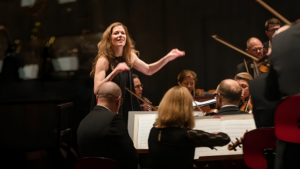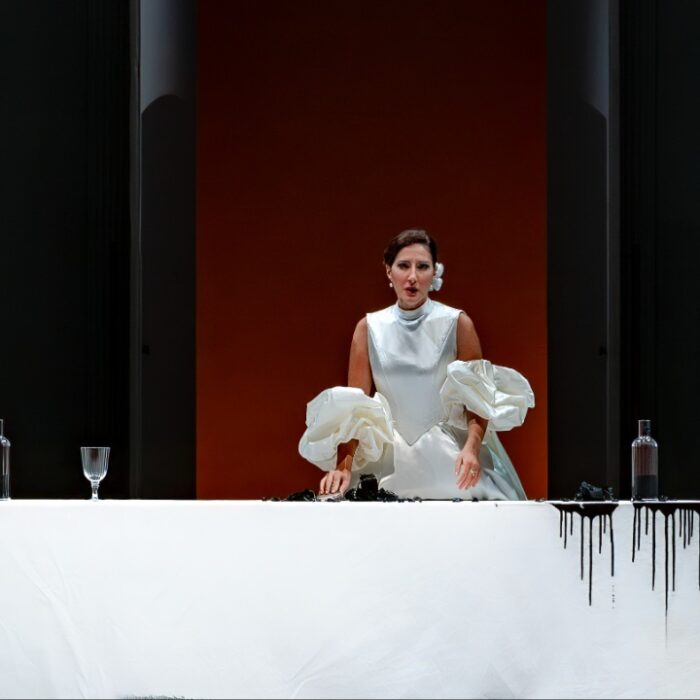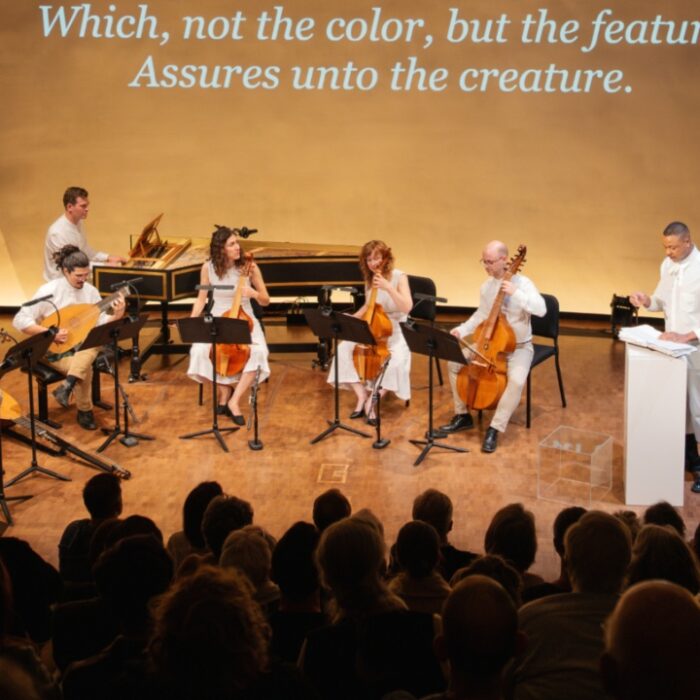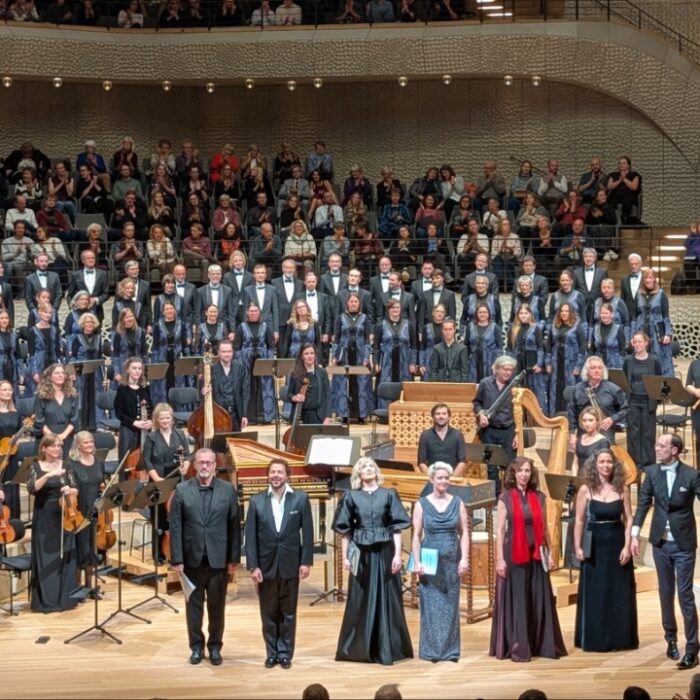
Swedish Radio Choir 2024 Review: Igor Stravinsky’s ‘The Rake’s Progress’
By John Vandevert(Photo Credit: Dagens Nyhter/Mattias Ahlm)
On February 4, I had the pleasure of seeing Igor Stravinsky’s, “The Rake’s Progress,” for the first time. Having only read about the opera, I hadn’t come to realize how satirical Stravinsky could really be. Shostakovich and Prokofiev have been my references for the identity of Russian musical satire.
Leading the Swedish Chamber Orchestra was the luminary Barbara Hannigan, a legendary figure in the realm of contemporary music and a vanguard of a new era of musical eloquence. Filling out the cast were Tamara Bounazou (Anne Trulove), Elgan Llyr Thomas (Tom Rakewell), Douglas Williams (Nick Shadow), Robin Bailey (Auctioneer), Maggie Reneé (Baba The Turk), and Tristan Hambleton (various). A glorious night of Stravinsky’s music was treated with great respect and then some!
A Bit of Context
In describing the musical language of Igor Stravinsky’s three-act opera, “The Rake’s Progress,” Jonathan Scott called it “‘classical’ neoclassical,” although Stravinsky hated the term, and boy was he right. The first long-form work written for the theater, and his first English work, Stravinsky’s penultimate opera. It reflected the composer’s desire “to consolidate his arrival in the New World,” as Scott eloquently puts it. But equally as important as Stravinsky’s Dvorakian epiphany is the opera’s obvious topicality for our world today. A tale where everyone loses, no one loses. There’s nothing to win or lose at all, seeing as everyone is but a mad fool anyways, Stravinsky, with the librettist cooperation of luminary W H. Auden and Chester Kallman. The story of the damned Tom Rakewell and his dance with the devil is hardly foreign to today’s audiences. In an era of hyperrealism and superfiction demonstrations of fiction-as-fact-as-truth itself, there’s little that keeps any of us from falling off the Rota Fortuna into neurotic oblivion. Forever stuck between two facades, one for ourselves and one for everyone else, “The Rake’s Progress” is, at its core, a counterproductive tale which sees efforts wasted, performer and audience alienated, and the intellect stuped by a mixture of epochs, beliefs, and feelings which lead nowhere at an incredible pace.
The music juxtaposes classical with modern and baroque, disorienting one into a state of willful psychosis where nothing is coherent yet somehow we see a light at the end of a seemingly endless tunnel only to realize it’s just a light bulb hanging precariously by a worn-down cord. As Scott so eloquently puts it, “Dislocated, alienated, late-modern man mourns the loss of wholeness, the loss of innocence,” and yet in true metamodernist fashion life keeps going, you remain alive, and you must make sense of an upside down world which leaves little for the conscious person to rationalize. Mozart is disillusioned, the Hellenic balance is upturned, and logic is sacrificed at the altar of the Devil who, in this case, could be construed as post-WW2 fatigue, pre-WW2 hope, and pre-WW1 optimism. “Mozart with a few wrong notes” the bourgeois say as they passively take in an opera which so unambiguously defames their existence.
What is an opera without reprobation?
The funny part is that the opera really has no moral other than up is down, down is up, you’re a slave to feeling, you’re a slave to logic, you’re a slave to morality itself, if it still exists. Life is un acte gratuit, there’s little tying anything together, no teleology driving us towards some known end, everything can’t be rationalized, and little ever makes sense if you try. Tom lost everything for Venus and Venus could do nothing but watch and sing her lullaby. Or, Tom lost everything for a lover who eventually failed him. Or, Tom lost his soul to the Devil because he was weak and scared. Who can actually give a reading of Tom other than Tom. Of course, Tom can’t do that now and that’s the point. Life has no meaning, and the meaning you think it holds is eventually denatured anyways so what’s the point? In Scott’s words, “Two world wars had destroyed any utopian illusion of a civilized society.” Aha, so there it is. The moral of the opera, Stravinsky’s raison d’etre. But what can be done now other than just sigh?
Jagged Beauty All Around
As the immoral “Rake,” Elgan Thomas encapsulated the dexterity, natural exuberance, unshackled tenacity, and sublime eloquence of the modern leggiero tenor. Throughout his well-developed registers, mixing and adroitly using cuperto when needed, Thomas personified the despondency and futility of Tom with uncanny particularity. With a spin that seemingly halted for no one, he sang for the Metropolitan Opera House and not Berwaldhallen, a wise and apt choice considering others in his cast chose the antithesis much to their detriment. I hardly refrained myself from blushing when, in Act one and Act three, he sang so sweetly and beautifully to Bounazou. While in Act two, I seemed to have blushed for many contrasting reasons, emanating in no small way, from Thomas’ elegant hubris conveyed, and rightly so, through his stature and able voice which carried on, spin the feelings and pains of the world-weary Tom. The jagged passages of Stravinsky’s writing proved mere childsplay. His dexteriousness remains unsullied throughout the toughest and thickest of climaxes, arias of high energy and recurring demands of high tessituri, working Thomas’ exceptionally stable voice. What a joy to hear an actual leggiero. The legacy of Caruso, Björling, and Del Monaco seems in excellent hands, one fine young tenor at a time.
Now, when speaking about Bounazou, it’s hardly kowtowing to give unmitigated praise to a soprano who, in such scrupulous subtly, graceful vigor, and rich beauty, handled Stravinsky’s tortuous lines and arduous dynamic contrasts with such dignity. How university training produces such a consummate artist, one may never understand. But it can be said in honesty that Bounazou is an artist and as an artist, she painted a picture. In Act three, I nearly cried. She made me tear up when singing to the confused and lost Tom her sweet, safe lullaby. My own mother would do just that when I couldn’t sleep and so, her fond caressing of Tom with her pianissimo and velvet lyricism nearly pushed me, and I’m sure others, to emotional disarray. In more practical terms, Bounazou is a technician of the highest order, as every rhythmic passage, difficult melodic contour, and a cappella moment was handled with precision but never at the expense of phrasing. An obvious hallmark of Hannigan’s guidance given her own relationship with contemporary works of exceptionally difficult degree. Bounazou always continued the line, moved with the line, and never stopped short of its natural climax built into the fabric of Stravinsky’s writing. Sutherland’s spirit was conveyed that night and I’ll never forget it.
Filling out the cast were a collection of equally fine singers, Robin Bailey as the maniacal Auctioneer, Maggie Reneé as the Baba the Turk, and Douglas Williams as the Devil. All three of these singers were brilliant in their handling of Stravinskian musical language of course, the sharp rhythmic undulations, and precarious musical curvilinearity. William’s robust voice conveyed the magnitude of his character, although in my view much of the writing rarely allowed him to show his voice, favoring his role as recitative-heavy rather than an aria-focused alternative despite his two formidable arias in Act one and Act three. He too made me blush with his centurion presence and strong voice, but that’s what he was supposed to do as the Devil, no? As the Auctioneer, Bailey’s voice was another exceptional display of leggiero exuberance, with a spin that cut and soared as it went. There was a natural quality to the voice, an unchanged earnestness that both Thomas and Bounazou conveyed. As for Renee, despite the clear adeptness demonstrated in her performance, there was little that I can evaluate given how quiet she was throughout the performance. Whether it was by the range, personal choice, or inevitability, her resonant voice could only be heard on occasion and when it was, I very much savored what I heard. The role didn’t suit her, but she was dramatic and over the top, exactly what one wanted!
Some Points of Improvement
It didn’t take musical training to recognize the sheer gymnastic feats performed that night. From climax to climax, apex to apex, Thomas’ saw blade intervals to Bounazou’s Caballean dynamics, from melodic non-melodies to comical harpsichord recitatives, everyone, and I truly mean everyone, was brilliant. From the Grecian chorus whose musicality remain untainted by the dramatics required of them, the conductor’s kinaesthetic articulations of the beat which never alienated lyrical prosody but always infused each musical morpheme with its due vitality, to each and every musician, Bravi!
That being said, there were several aspects that were quite distracting, none more than the lighting. Although effective in some places, it was relatively incompatible with the hall, not to mention the staging. As a rather traditional opera lover, and having trained as a singer myself, I find stationary oratorio style far more apt for performances of operas within the hall rather than attempting to perform an opera on an inadequate stage with inadequate room and a lack of resources. Not to chide the good work of director Josie Daxter, for her expertise dually showed in the nuanced approach towards using red and blue light, but outside the singing the staging felt cramped and limited which could have been solved by simply having the singers stand and sing, interact lightly, but just left alone. The costumes were fine, a modern choice of apparel was a fitting contemporary touch, but overall the staging was ineffective only because of the lack of space and not because of the fault in Daxter’s talent per se. The opening entrance of the chorus, the men and women sauntering by Tom and donning individual persons, was brilliant, a brilliant touch to an otherwise mundane task.
The other major issue, and which must be rectified in Berwaldhallen practice going forward for operas of any kind so please do take care, is the program and the ineffective way in which the acts and the roles of the singers are dealt with in the program. As it stands, the program didn’t say where the intermission was and the couple beside me were just as lost as I was as to where we were in the narrative. As it turned out, the intermission was in the middle of Act two, thus splitting the opera in a relatively advantageous place. The problem is not the intermission, but that it was not adequately stated in the program, or at least not where the synopsis was. Furthermore, when it comes to the singers, because some of the cast were singing in multiple roles, trying to understand who-was-who was nearly impossible, considering some of them even looked the same. The roles should always be by the performers and not the voice-type, to the average person that doesn’t matter, what even is a soprano? That isn’t something that matters to the average concert goer. Rather, they want to know who is performing in what role and what is the story.
Overall, it was a brilliant performance by some brilliant musicians and I highly recommend you attend Berwaldhallen’s Swedish Radio Choir performances when you can, they are not to be missed it seems!


